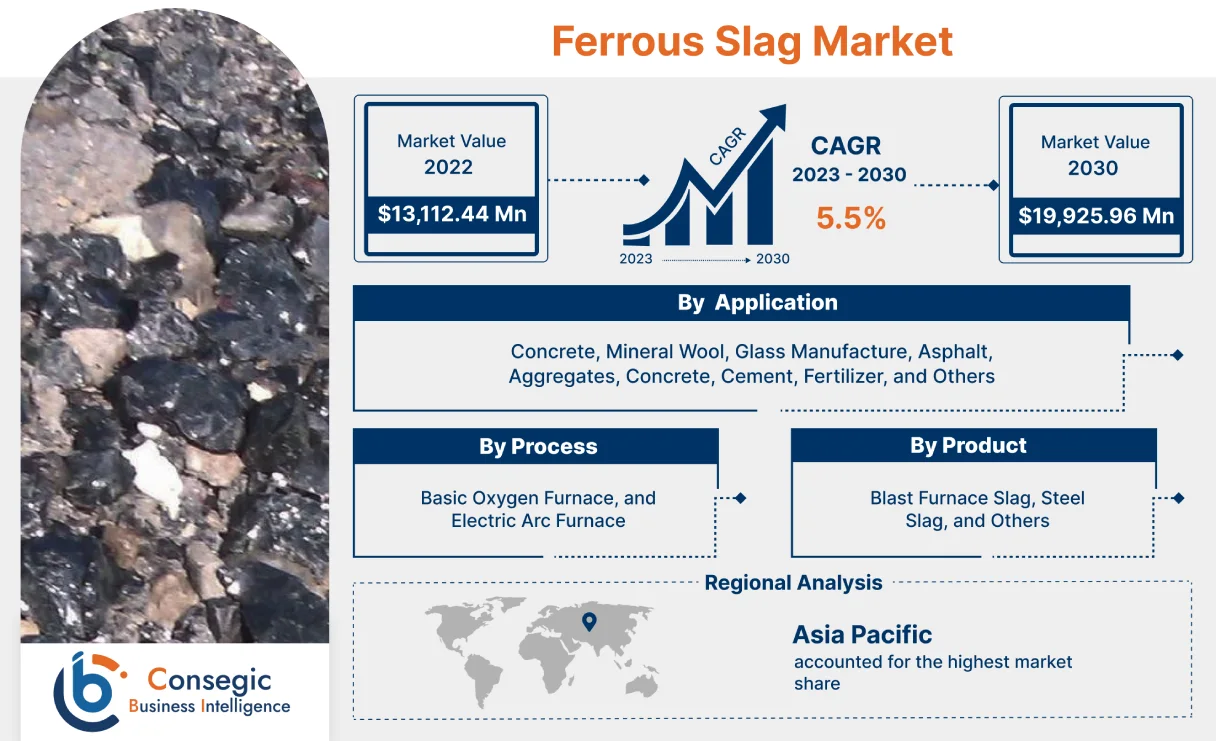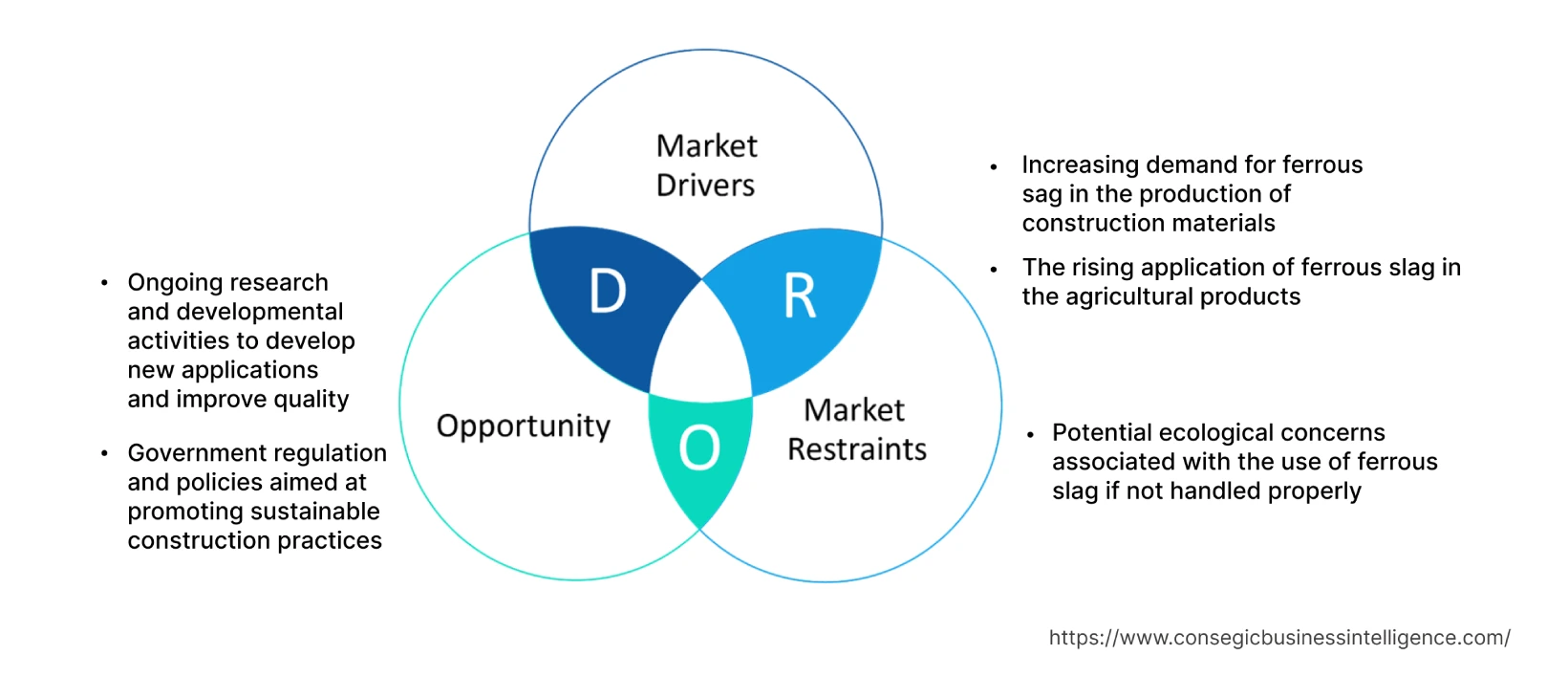- Summary
- Table Of Content
- Methodology
Ferrous Slag Market Introduction :
Consegic Business Intelligence analyzes that the ferrous slag market is growing with a CAGR of 5.5% during the forecast period (2023-2030), and the market is projected to be valued at USD 19,925.96 Million by 2030 from USD 13,112.44 million in 2022.
Ferrous Slag Market Definition & Overview:
Ferrous slag is a by-product of iron- and steelmaking, produced by the mixing of various materials including dolomite, limestone, and silica sand with steel and blast furnaces. Such materials are added to remove the impurities from the scrap, iron ore, or other ferrous feeds. Ferrous slag has a wide scope of application in the construction materials such as concrete, cement, and asphalts, among others. Moreover, ferrous slag is also deployed in agricultural products including fertilizers due to the ability to provide potential nutrients such as silica, calcium, and magnesium.
Ferrous Slag Market Insights :
Key Drivers :
Increasing demand for ferrous sag in the production of construction materials
Ferrous slag is widely used in the production of construction materials owing to the properties such as lower thermal conductivity and high hardness. The pretreated steel slag can be used as aggregate in the production of asphalt or concrete, ferrous slag can be used directly for road construction. The rising infrastructure investments and growing demand for residential and commercial building is driving the need for construction materials. For instance, according to the European Construction Industry Federation (FIEC), construction investment in Europe accounted for USD 1,734.86 billion in 2021. Hence the increasing demand for ferrous slag in the production of construction materials is accelerating the growth of the ferrous slag market.
The rising application of ferrous slag in the agricultural products
The wide scope of application of ferrous slag in agricultural products including fertilizers is attributed to the ability of the material to provide micronutrients such as calcium, magnesium, and aluminum, among others. Moreover, ferrous slag helps in the removal of excess Co2 and improves heavy metal stabilization. The rising agricultural activities owing to the growing advancements in agricultural practices such as organic farming, and precision agriculture is propelling the need for these micronutrient based products Therefore, the rising application of ferrous slag in agricultural products to enhance soil fertility and productivity is driving the growth of the ferrous slag market.
Key Restraints :
Potential ecological concerns associated with the use of ferrous slag if not handled properly
Ferrous slag contains heavy metals including manganese, iron, and copper, among others that could significantly impact the environment if not handled properly. The excess use of ferrous slag cause soil pollution and water pollution. Moreover, ferrous slag is alkaline in nature and heavily used in construction materials. The release of ferrous slag into the surrounding environment could result in changing the pH value of the soil. Hence, the potential ecological concern associated with the use of ferrous slag is likely to hamper the market growth.
Future Opportunities :
Ongoing research and developmental activities to develop new applications and improve quality
Ongoing research and developmental efforts in the field of ferrous slag utilization to introduce new technologies and manufacturing processes that are likely to help improve the quality of the ferrous slag is projected to create lucrative opportunities in the market. Moreover, innovation in the processing technique to develop new applications is also expected to present significant opportunities in the ferrous slag market.
Government regulation and policies aimed at promoting sustainable construction practices
The rising concern toward the environment regarding conventional construction materials is urging the government of various countries to implement regulations and policies. Such policies and regulations are aimed at promoting sustainable construction practices and the reduction of waste material. For instance, European Commission's Construction Products Regulation (CPR) is aimed at the promotion of sustainable waste management practices and encourages the use of recycled materials in construction. Therefore, the extensive use of ferrous slag in sustainable construction practices due to the potential to reduce carbon emissions is expected to boost the demand for ferrous slag.
Ferrous Slag Market Report Insights :
| Report Attributes | Report Details |
| Study Timeline | 2017-2030 |
| Market Size in 2030 | USD 19,925.96 Million |
| CAGR (2023-2030) | 5.5% |
| By Process | Basic Oxygen Furnace, and Electric Arc Furnace |
| By Product | Blast Furnace Slag, Steel Slag, and Others |
| By Application | Concrete, Mineral Wool, Glass Manufacture, Asphalt, Aggregates, Concrete, Cement, Fertilizer, and Others |
| By Region | North America, Europe, Asia-Pacific, Latin America, and Middle East & Africa |
| Key Players | Nippon Steel Corporation, Edw. C. Levy CO., Stein, Inc., JFE Steel Corporation, Arcelor Mittal, NLMK, TMS International, JSW Steel, Millennium Multi Trade Pvt. Ltd. |
Ferrous Slag Market Segmental Analysis :
Based on the Process :
Based on the process segment the market is divided into basic oxygen furnace and electric arc furnace. In 2022, the basic oxygen furnace segment accounted for the highest market share. The growth of the segment is attributed to the wide adoption of basic oxygen furnace. A basic oxygen furnace converts liquid blast-furnace scrap and iron into steel by using pure oxygen. The expanding steel industry due to the extensive use of steel as raw material and intermediary materials in various other end use industries including construction and transportation is driving the growth of the segment.
However, the electric arc furnace segment is expected to register the fastest CAGR over the forecast period. An electric arc furnace is a process in which iron is melted using an electric source. The rising demand for the electric arc furnace due to high efficiency, and low operating cost is anticipated to surge the demand for the procedure for the production of ferrous slag.
Based on the Product :
The product segment is categorized into blast furnace slag, steel slag, others. In 2022, the blast furnace slag segment held the highest share of 45.05% in the market. The extensive application of blast furnace slag in the concrete mixtures for mass concreting works such as bridge abutments, and dams is driving the growth of the segment. Blast furnace slag provides higher ultimate strength, and capacity to fill pores efficiently. In addition, the product has excellent resistance to chloride and sulfate attacks, thereby being used in places that are susceptible to these attacks. Hence, the wide scope of applications of blast furnace slag is propelling the growth of the market.
Moreover, the steel slag segment is expected to witness the fastest CAGR over the forecast period. In the construction material sector, steel slag is used as a binder and aggregates in stabilized base courses. The rising construction activities due to the increasing demand for commercial and residential buildings is anticipated to proliferate the market growth. For instance, Edw. C. Levy Co., headquartered in the U.S., offers aggregates used in the building & construction industry. Moreover, the rising concern toward the environment is also increasing the demand for steel slags as they are used to reduce environmental impacts.
Based on the Application :
The application industry segment is categorized into concrete, mineral wool, glass manufacture, asphalt, aggregates, concrete, cement, fertilizer, and others. In 2022, concrete segment accounted for the highest market share in the ferrous slag market. The wide scope of applications of concrete owing to its versatility and cost-effectiveness is contributing to the growth of the segment. The increasing government expenditures for reconstruction and development to repair infrastructures including bridges, roads, and railways is driving the demand for concrete. For instance, according to Invest India, by 2025, the construction industry in India is projected to reach USD 1.4 trillion. Thus, the above-mentioned factors are proliferating the ferrous slag market.
Moreover, the fertilizer segment is expected to register the fastest CAGR over the forecast period. The rising demand for agricultural products that provide soil fertility and high crop yield is anticipated to drive the demand for fertilizers in the market. In addition, the rising need for sustainable and environment-friendly fertilizers is also expected to contribute to the growth of the segment.
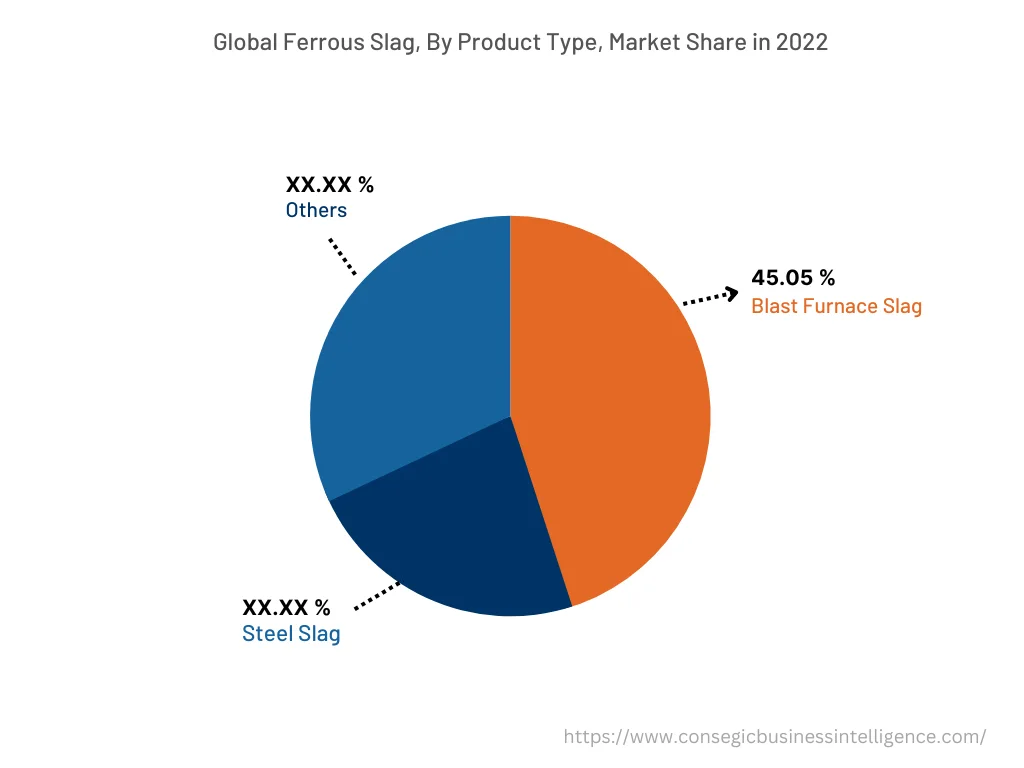
Based on the Region :
The regional segment includes North America, Europe, Asia Pacific, Middle East and Africa, and Latin America.
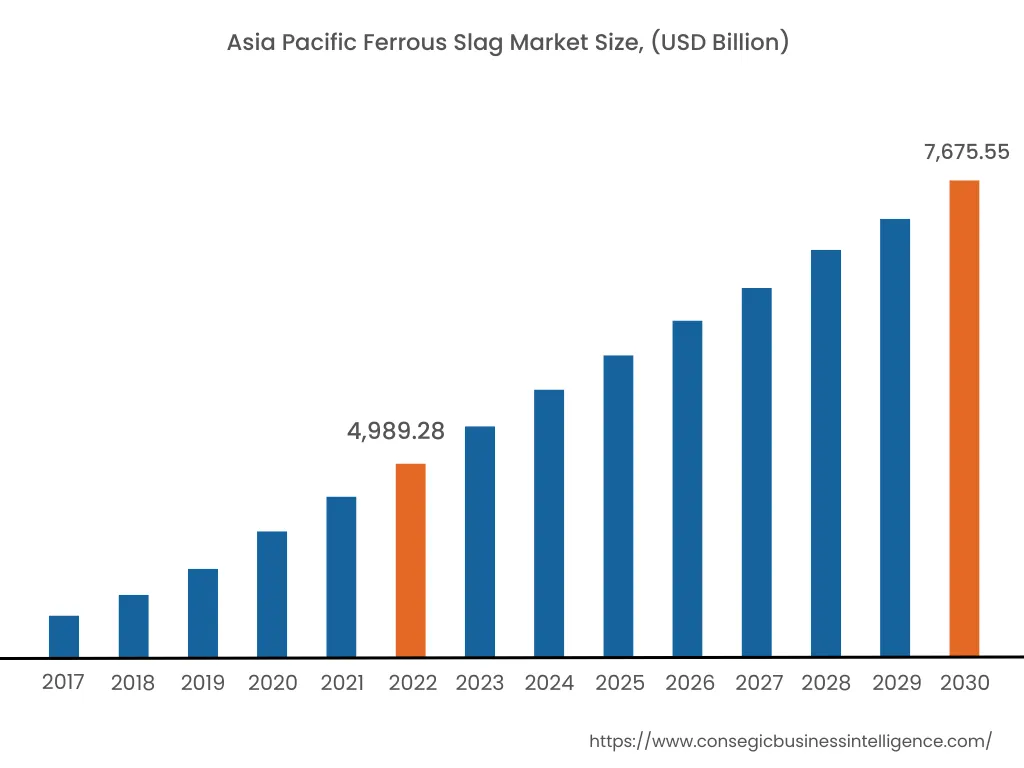
In 2022, Asia Pacific accounted for the highest market share at 38.05% and was valued at USD 4,989.28 million, and is expected to reach USD 7,657.55 million in 2030. In Asia Pacific, China accounted for the highest market share of 39.85% during the base year of 2022. The rising construction activities are driving the demand for construction materials including ferrous slag. Moreover, the rising agricultural practices in the region particularly in the growing economies such as India and China are proliferating the demand for ferrous slag market.
However, North America is expected to register the fastest CAGR of 6.3% during the forecast period. The rising concern about the use of conventional construction materials is expected to drive the demand for sustainable and eco-friendly construction materials including ferrous slag. For instance, in 2021 the U.S. government released the GREEN Building Jobs Act to establish energy-efficient programs and requirements for federal buildings, focusing on the reduction of the greenhouse gas emission, water, and energy consumption. The rising demand for residential and commercial buildings is also expected to surge the growth of the ferrous slag market.
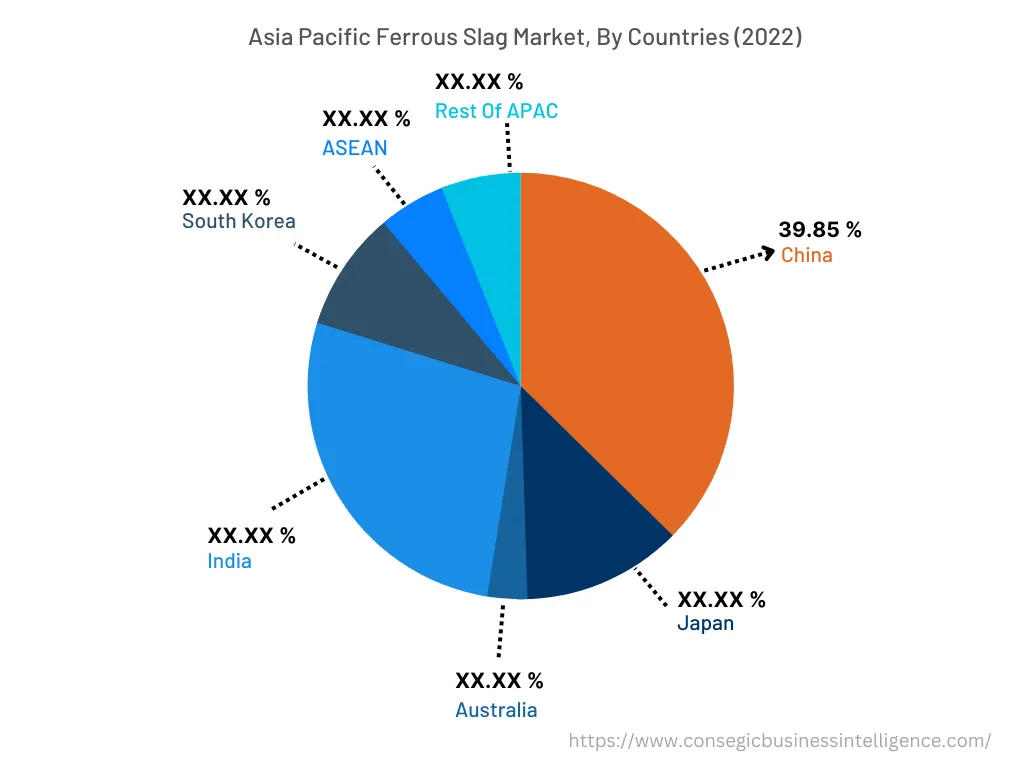
Top Key Players & Market Share Insights:
The ferrous slag market is highly competitive, with several large players and numerous small and medium-sized enterprises. These companies have strong research and development capabilities and a strong presence in the market through their extensive product portfolios and distribution networks. The market is characterized by intense competition, with companies focusing on expanding their product offerings and increasing their market share through mergers, acquisitions, and partnerships. The key players in the market include-
- Nippon Steel Corporation
- Edw. C. Levy CO.
- TMS International
- JSW Steel
- Millennium Multi Trade Pvt. Ltd.
- Stein, Inc.
- JFE Steel Corporation
- Arcelor Mittal
- NLMK
Recent Industry Developments :
- In May 2023, Nippon Steel Corporation announced the shift of the studies from the blast furnace steelmaking process to the electric arc furnace by deploying the Setouchi Works Hirohata Area and the Kyushu Works Yawata Area as studying sites
- In June 2022, JFE Steel Corporation acquired EcoLeaf which is a Japanese EPD (Type Ⅲ environmental declaration) program by Sustainable Management Promotion Organization (SuMPO).
Key Questions Answered in the Report
What was the market size of the ferrous slag industry in 2022? +
In 2022, the market size of ferrous slag was USD 13,112.44 million
What will be the potential market valuation for the Ferrous Slag industry by 2030? +
In 2030, the market size of ferrous slag will be expected to reach USD 19,925.96 million.
What are the key factor driving the growth of the ferrous slag market? +
Increasing demand for ferrous sag in the production of construction materials such as concrete, cement, and aggregates, is the key factor driving the growth of the ferrous slag market.
What is the dominating segment in the ferrous slag market by product type? +
In 2022, blast furnace slag accounted for the highest market share of 45.05% in the overall ferrous slag market.
Based on current market trends and future predictions, which geographical region will have the fastest impact on the Ferrous Slag market's growth in the coming years? +
North America is expected to be the fastest-growing region in the market during the forecast period.
